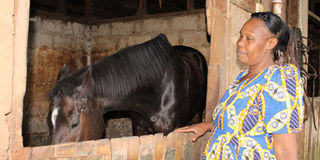Kenyan farmers feel pain of global disruption of animal feed ingredients trade

Anne Nthenya, a farm manager, is seen at a horse stable in a farmhouse in Limuru, Kiambu County, Kenya, Aug. 2, 2021. As the pandemic continues to hamper international tourism, more Kenyans become keen on local agro-tourism. PHOTO/CHRISPINUS OMAR/XINHUA
What you need to know:
- The Food and Agriculture Organization (FAO) of the United Nations estimates that there are some 18 million cattle in Kenya, 18 million sheep, 28 million goats, 3 million camels, about 400,000 pigs and 32 million poultry.
For the first time in seven years, Kenyan farmer Jessica Wanjuki, who keeps more than 150 chickens on the outskirts of Nairobi, has decided to free-range them.
Over the years, she has been feeding the improved indigenous birds commercial rations, getting eggs and meat for sale. The farmer, however, cannot sustainably do it anymore as the cost of commercial feeds in the east African nation hits a record high.
"Keeping the chickens in their cages full-time is no longer sustainable. The cost of a 70 kg bag of feed has increased from 2,200 shillings (about 20 U.S. dollars) to 25.5 dollars in about three months," said Wanjuki. The cost of feed in Kenya has been pushed up by scarcity of animal feed ingredients that include soya, sunflower cake, fishmeal, wheat pollard, maize and maize germ and cotton seed cake.
Kenya hardly produces enough of the ingredients, including maize -- the country's staple -- thus relies on imports. While some of them such as maize and cotton seed cake are sourced from neighboring countries, including Uganda, Zambia and Tanzania, others like soya and sunflower cake are sourced from as far as China. A global shortage of most of the ingredients has seen thousands of Kenyan farmers dig deeper into their pockets to feed their cows, chickens and pigs. The worst hit are chicken and pig farmers as the majority of them wholly rely on commercial rations.
Unlike dairy farmers, who only buy commercial concentrates to feed their animals during milking, poultry and pig keepers fully rely on the feed. "My production costs have doubled making pig farming an unprofitable venture," said Fred Kimetto, a pig farmer in Uasin Gishu in the Rift Valley. Kimetto buys a 70 kg bag of feed depending on the stage of growth of the animals at between 23 dollars and 30 dollars, up from 18 dollars and 26 dollars.
"The challenge is that as the cost of production increases, the price of livestock products has not increased to cushion us from losses," said Kimetto.
Joseph Karuri, chairman of the Association of Kenya Animal Feeds Manufacturers (Akefema), blamed the current increase in prices to COVID-19 disruption, which has affected global supplies. According to him, Kenya produces low quantities of soya beans, sunflower or cotton whose by-products are soybean meal, sunflower and also cotton seed cake are major sources of protein in the manufacture of animal feeds.
"Kenya entirely depends on imports from Tanzania, Uganda, Malawi and Zambia but the adverse effects of COVID 19 have hurt supplies. The countries have constrained supplies," he said.
As Kenya struggles to import, some growers of the animal feed ingredients in Kenya are exporting them to markets like the United Arab Emirates where prices are high. Among those being exported are wheat bran, sunflower cake, wheat pollard and maize germ. Global prices of the products have increased by between 30 percent and 200 percent since 2020.
Erratic rains in Kenya have also compounded problems for farmers after affecting maize production. Kenya is expected to record declined maize production this season due to low rains in growing areas of the Rift Valley. The country is expected to harvest less than its annual average maize production of 40 million bags against a consumption of over 52 million bags.
"It is a tough time being a livestock farmer in Kenya. This is no longer profitable business. One now has two options, either to sell the animals and quit the business or scale down operations until prices come down," said Kimetto, the pig farmer, noting that formulating animal feeds on the farm to cut costs is not an option since the cost of ingredients have gone up, with some like soya and fishmeal not readily available.
The Food and Agriculture Organization (FAO) of the United Nations estimates that there are some 18 million cattle in Kenya, 18 million sheep, 28 million goats, 3 million camels, about 400,000 pigs and 32 million poultry. The livestock is kept by about 7 million smallholder households. Beatrice Macharia of Growth Point, an agro-consultancy in Kajiado, noted that Kenya's main undoing is using maize and other human feed products to make animal rations.
"That competition certainly brings problems in times of scarcity. Kenya has not embraced yellow maize as an animal feed ingredient to avoid reliance on white maize, which is human food," she said.




